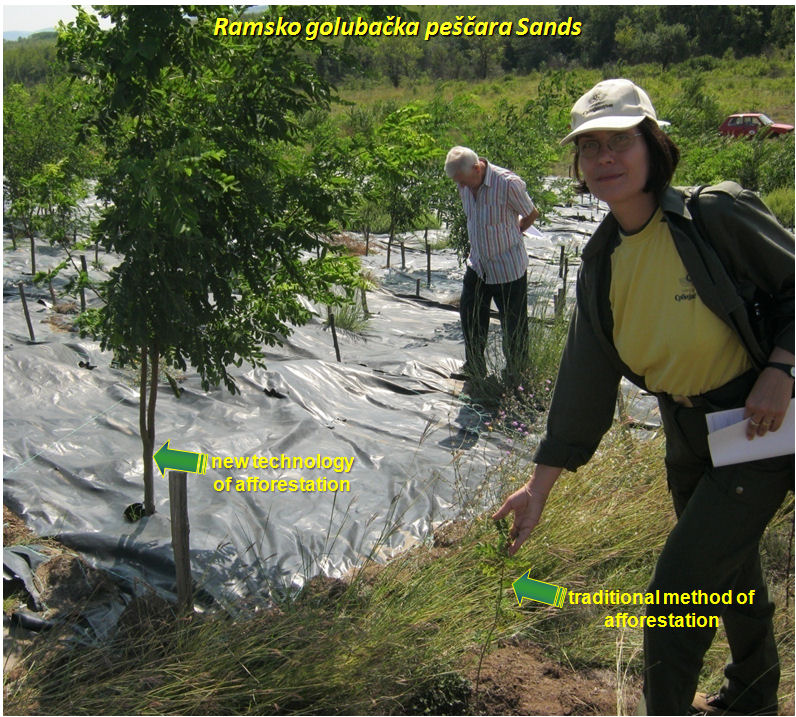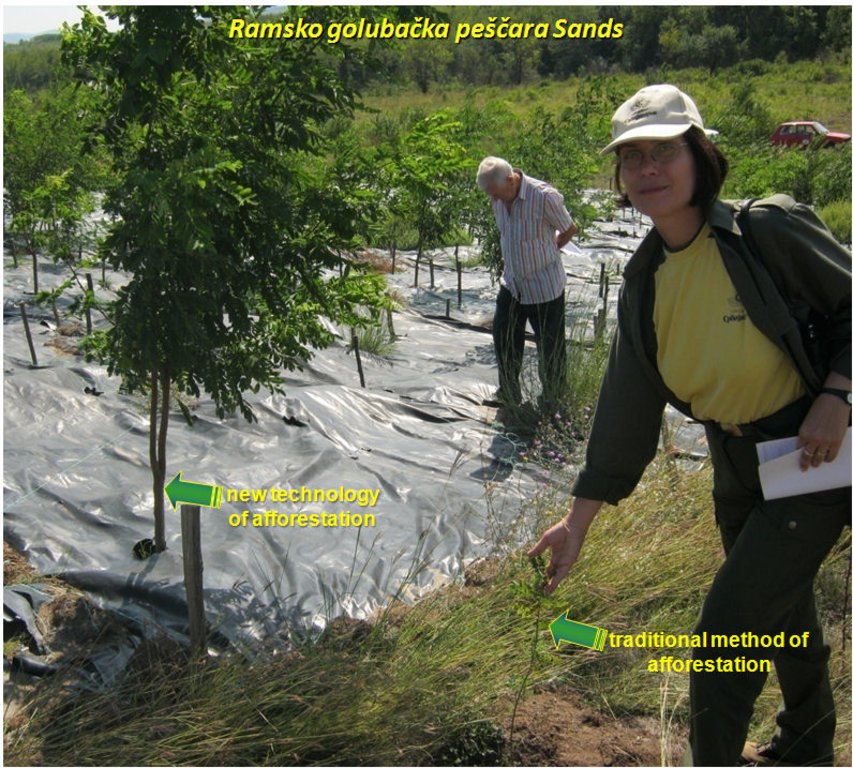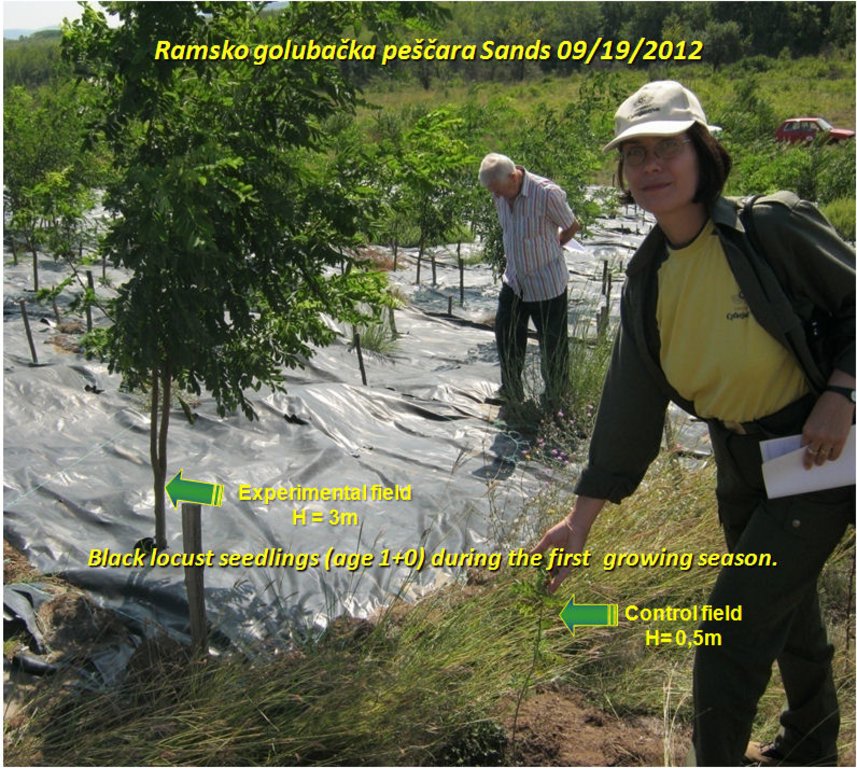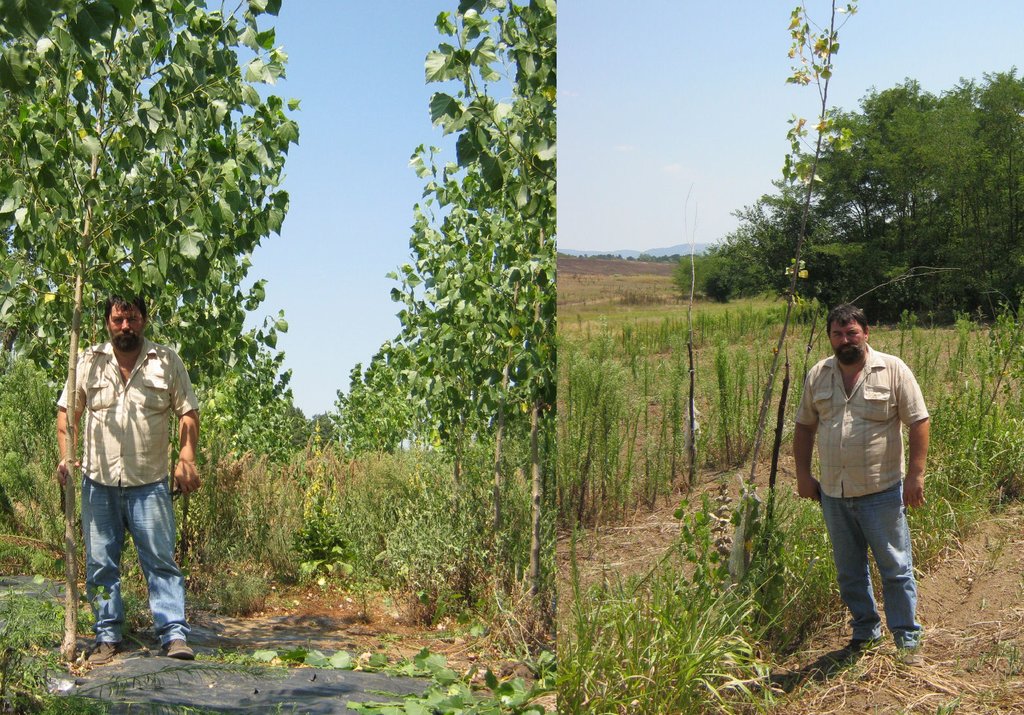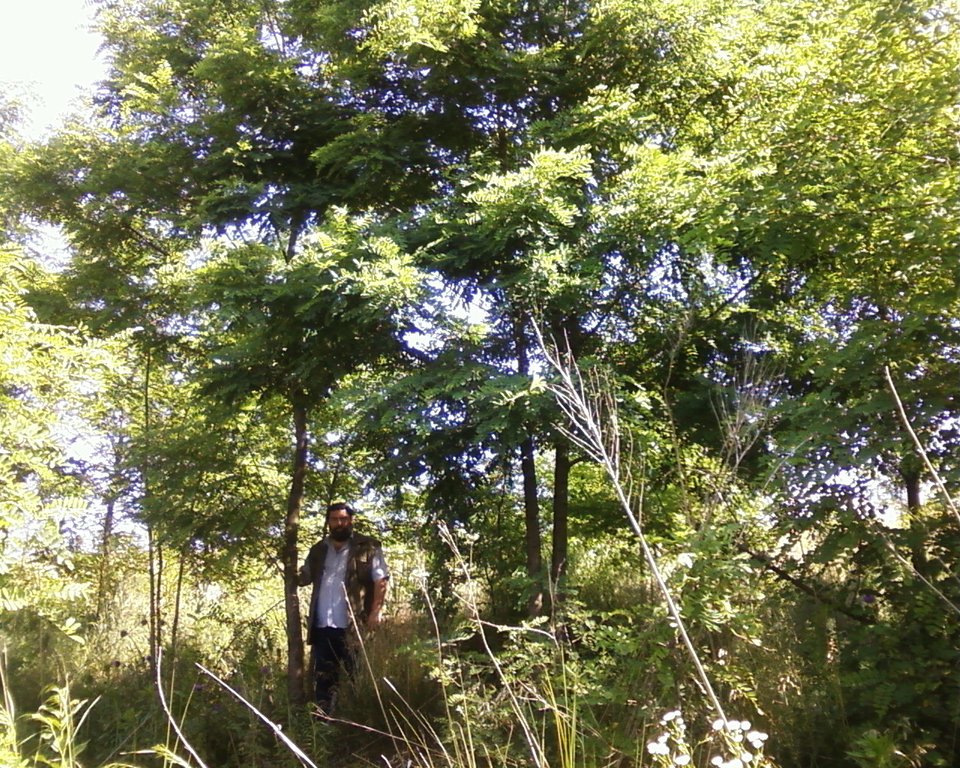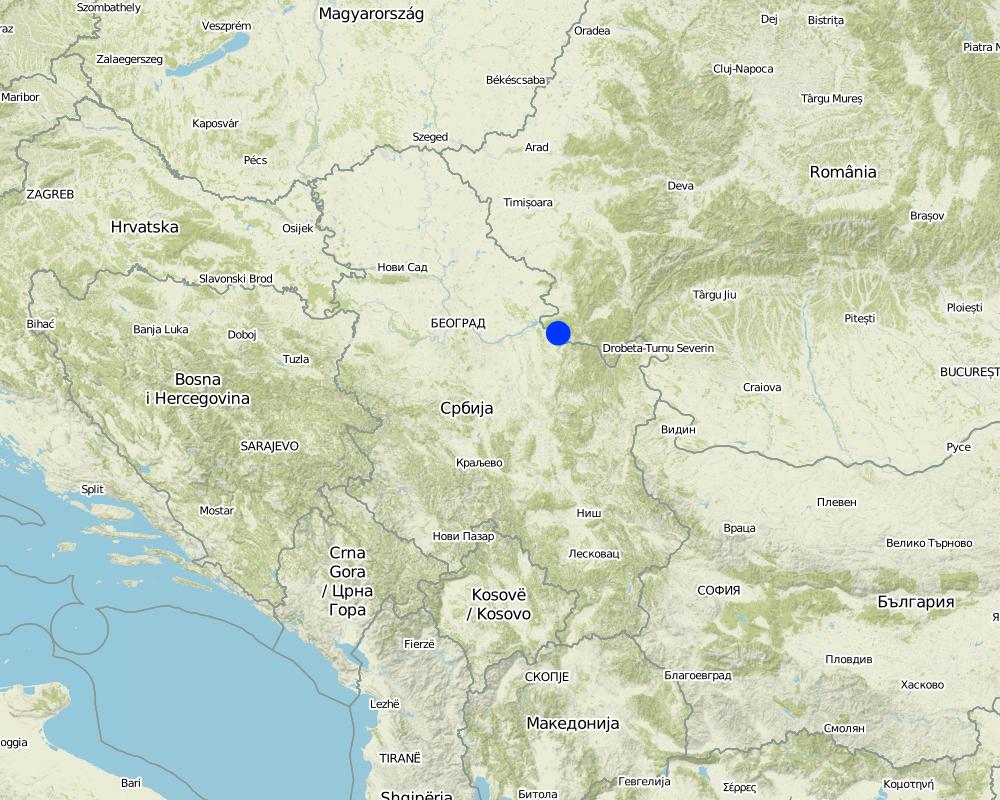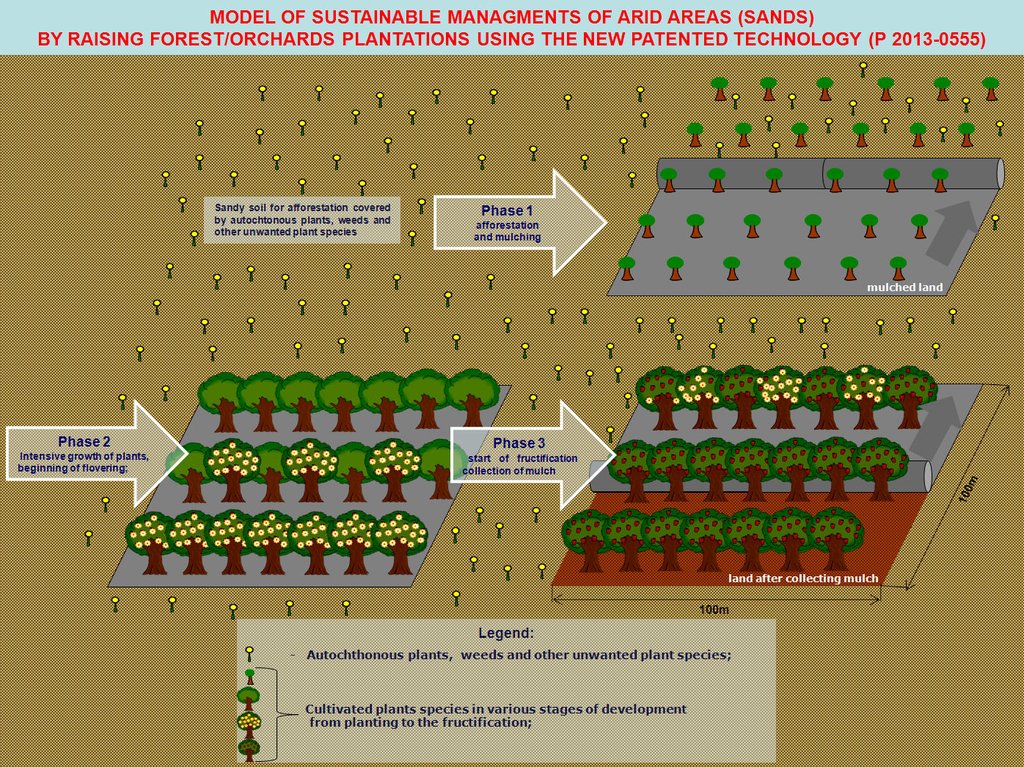New patented technology of raising forest and orchards in the extremely unfavorable environmental conditions [Sérvia]
- Criação:
- Atualização:
- Compilador/a: Blagoje Pejić
- Editor: –
- Revisor: Alexandra Gavilano
The Procedure Complete Mulching of Land In Order to Raise Young Plantations of Woody Plants Under Unfavorable Climate Conditions P 2013 - 0555
technologies_500 - Sérvia
Veja as seções
Expandir tudo Recolher tudo1. Informação geral
1.2 Detalhes do contato das pessoas capacitadas e instituições envolvidas na avaliação e documentação da tecnologia
1.3 Condições em relação ao uso da informação documentada através de WOCAT
O compilador e a(s) pessoa(s) capacitada(s) aceitam as condições relativas ao uso de dados documentados através do WOCAT:
Sim
1.4 Declaração de sustentabilidade da tecnologia descrita
A tecnologia descrita aqui é problemática em relação a degradação da terra de forma que não pode ser declarada uma tecnologia de gestão sustentável de terra?
Não
Comentários:
This technology does not pollute the environment and completely excludes the use of chemical agents in the control of undesirable plant species.
2. Descrição da tecnologia de GST
2.1 Descrição curta da tecnologia
Definição da tecnologia:
The technological process of complete mulching with specific materials (P 2013 – 0555) has a positive impact on the development, e.g. the growth intensity and the growth time of the cultivated plant species. This technology allows to grow plants without additional irrigation in rather poor habitat conditions (high temperature, insolation, etc.).
2.2 Descrição detalhada da tecnologia
Descrição:
1. This technology has been applied in arid conditions Ramsko golubačka peščara Sands (East Serbia). This semi deserts is one of three located in Serbia. As is known, all the ecosystems (agro, forest and water ecosystems) in the surrounding of sands and deserts are highly endangered by wind erosion, which causes movement and transport of the sand and damage to people, agronomy and biodiversity. This is poor area, inhabited by the Roma population - highly affected by the consequences of moving sands;
2. This process of complete mulching of land with specific polyethylene foil enables use of poor habitat conditions (high temperature, insolation and etc) tor a positive impact on the development of plants. This innovative technology provides fully use of the reserves of moisture and mineral matters in the soil, as well as intensification of the process of photosynthesis of cultivated plants, which are the main reasons for the rapid growth and exceptionally good overall condition of young plantations
3 The purpose of this technology is to increase success of the procedure and ensure the achievement of the targeted functionality of woody plants (binding and greening sands, ensuring of food and wind shelter for humans and wild animals, increasing biodiversity) in a much shorter period of time than traditional methods afforestation.
4. In relation to the works that follow the classical techniques to raise woody plants, for this patented technology is necessary to additionally provide a trained workforce for the setting up of mulch, specific material for mulching and license to use the patent. To establish this technology trained workforces are required to set up the specific materials for mulching, taking care of the plants, as well a license to use the patented technology must be acquired
5. Based on the principle “make it and leave it” this technological process enables the following conditions: no need for additional irrigation; no need for mechanical soil cultivation before afforestation; no need for additional manpower and works that are required in maintaining young forest plantations raised by classical methods of afforestation (hoeing, inter-row processing, harrowing, weeds and stump sprout removing...); in the next 3-5 years completely prevented the appearance of unwanted species of plants (weeds) without the use of chemicals; no environmental pollution; no soil erosion as well as rinsing and removal of humus on slopes; fructification of fruit tree species starting earlier, shelterbelts and snow protective belts are usable for far less time, the sands bind is faster, afforestation of degraded land and the process of rehabilitation and recultivation is shortened, production cycle of energy crops takes less time and give faster return on investment, binding of sands and stop wind erosion has a positive impact on the microclimate of whole sandy area and helps to increase the biodiversity as well as increase of yields of agricultural crop.
6. Although the cumulative amount of costs of implementing the patented technology is much lower compared to the works following the classic techniques to raise woody plants, an aggravating circumstance for the use of this technology may be the obligation to hold a license to use the patent and greater capital investment in the first year of plantation. Users especially likes fact that young plantations reaches the targeted purposes for drastically shorter time, without additional irrigation.
2.3 Fotos da tecnologia
Observações gerais sobre as fotos:
The pictures show the difference between the results of the use of traditional technology of afforestation and the use of new patented technologies of afforestation
2.5 País/região/locais onde a tecnologia foi aplicada e que estão cobertos nesta avaliação
País:
Sérvia
Região/Estado/Província:
Veliko Gradište
Especificação adicional de localização:
Ramsko golubačka peščara Sands
Especifique a difusão da tecnologia:
- Uniformemente difundida numa área
Map
×2.6 Data da implementação
Caso o ano exato seja desconhecido, indique a data aproximada:
- menos de 10 anos atrás (recentemente)
2.7 Introdução da tecnologia
Especifique como a tecnologia foi introduzida:
- durante experiências/ pesquisa
3. Classificação da tecnologia de GST
3.1 Principal/principais finalidade(s) da tecnologia
- Melhora a produção
- Reduz, previne, recupera a degradação do solo
- Preserva ecossistema
- Protege uma bacia/zonas a jusante – em combinação com outra tecnologia
- Preservar/melhorar a biodiversidade
- Reduzir riscos de desastre
- Adaptar a mudanças climáticas/extremos e seus impactos
- Atenuar a mudanças climáticas e seus impactos
- Criar impacto econômico benéfico
- Cria impacto social benéfico
3.2 Tipo(s) atualizado(s) de uso da terra onde a tecnologia foi aplicada

Floresta/bosques
- Plantação de árvores, reflorestamento
- Forest fruits plantations
Plantação de árvores, florestamento: Especificar a origem e composição das espécies:
- Monocultura de variedade local
- Variedades mistas
Produtos e serviços:
- Lenha
- Frutas e nozes
- Outros produtos florestais
- Conservação/proteção da natureza
Comentários:
Number of growing seasons per year: 1
3.4 Abastecimento de água
Abastecimento de água para a terra na qual a tecnologia é aplicada:
- Precipitação natural
Comentários:
This technological process exclude additional irrigation and provide enough moisture for the life of cultivated plant species without the need for irrigation young plants, relying only on the water from atmospheric precipitates.
3.5 Grupo de GST ao qual pertence a tecnologia
- Gestão de plantação florestal
- Quebra-vento/cerca de árvores
- Solo/cobertura vegetal melhorada
3.6 Medidas de GST contendo a tecnologia

Medidas estruturais
- S6: Muros, barreiras, paliçadas, cercas
- S11: Outros
3.7 Principais tipos de degradação da terra abordados pela tecnologia

Erosão do solo pela água
- Wt: Perda do solo superficial/erosão de superfície

Erosão do solo pelo vento
- Et: Perda do solo superficial
- Ed: deflação e deposição
3.8 Redução, prevenção ou recuperação da degradação do solo
Especifique o objetivo da tecnologia em relação a degradação da terra:
- Prevenir degradação do solo
- Recuperar/reabilitar solo severamente degradado
Comentários:
This is applicable model to combat desertification and sustainable management of Sands, using by the new technology of raising forest (and orchards) in arid areas, which ensure the achievement of the targeted functionality of woody plantations in a much shorter period of time than traditional methods afforestation, without additional irrigation, just relying on the existing atmospheric sediment
4. Especificações técnicas, implementação de atividades, entradas e custos
4.1 Desenho técnico da tecnologia
Especificações técnicas (relacionada ao desenho técnico):
This patented technological process of complete mulching of land enables use of poor habitat conditions (high temperature, insolation and etc.) for a positive impact on the intense growth and development of cultivated species of plants and provides, even in harsh environmental conditions, successful establishment of forest and orchards plantations, planting of new forests in areas where in the past did not exist and the conversion of stands of lower quality in higher silvicultural form, all without additional irrigation.
The news is a specific and layered process laying mulch and full coverage of land with specific, impermeable to water and light, synthetic materials over large areas. In this way, planted trees provides full access to the existing reserves of moisture and nutrients in the soil and suppress weeds, without the use of herbicides and pesticides and without the need for irrigation young plants, relying only on the water from atmospheric precipitates.
After completion of the production cycles, all the material used for mulching will be collected and recycled, which confirms that new technology has a zero degree of environmental pollution.
Autor:
Dr. Blagoje Pejić
Data:
19/09/2012
4.2 Informação geral em relação ao cálculo de entradas e custos
Especifique como custos e entradas foram calculados:
- por área de tecnologia
Indique o tamanho e a unidade de área:
1ha
Outro/moeda nacional (especifique):
€ (Euro)
Indique a média salarial da mão-de-obra contratada por dia:
35€ (gross amount)
4.3 Atividades de implantação
| Atividade | Periodicidade (estação do ano) | |
|---|---|---|
| 1. | Marking and measuring of places for planting | 2 workers (8hours) |
| 2. | Digging a hole for planting (40cm x 40 cm) | 11 workers (8hours) |
| 3. | Delivery seedlings | 4 workers (8hours) |
| 4. | Planting seedlings | 8 workers (8hours) |
| 5. | Placing (stacking) of mulch | 12 workers (8hours) |
4.4 Custos e entradas necessárias para a implantação
| Especifique a entrada | Unidade | Quantidade | Custos por unidade | Custos totais por entrada | % dos custos arcados pelos usuários da terra | |
|---|---|---|---|---|---|---|
| Mão-de-obra | workers | person - days | 37,0 | 35,0 | 1295,0 | |
| Mão-de-obra | skilled labor force | person - days | 3,0 | 100,0 | 300,0 | |
| Equipamento | Machine hours | working hours | 10,0 | 15,0 | 150,0 | |
| Equipamento | Tools | kom | 10,0 | 10,0 | 100,0 | |
| Material vegetal | Seedlings | kom | 1300,0 | 1,0 | 1300,0 | |
| Fertilizantes e biocidas | Zeolite | kg | 910,0 | 0,32 | 291,2 | |
| Material de construção | Material for mulching | square meter | 10000,0 | 0,22 | 2200,0 | |
| Outros | Licence | ha | 1,0 | 500,0 | 500,0 | |
| Outros | Transport of seedlings | Euro | 1300,0 | 0,01 | 13,0 | |
| Outros | Transport of workers | Euro | 37,0 | 0,7 | 25,9 | |
| Custos totais para a implantação da tecnologia | 6175,1 | |||||
| Custos totais para o estabelecimento da Tecnologia em USD | 6175,1 | |||||
Comentários:
The amount of the costs of raising young plantations (forest and orchard) refers to a period of 5 years, as planned duration of mulch. Based on the principle “make it and leave it”, during the period of duration of mulch, this technological process enables the following conditions: NO NEED for additional irrigation - provide enough moisture for the life of cultivated plant species without the need for irrigation young plants, relying only on the water from atmospheric precipitates; NO NEED for mechanical soil cultivation before afforestation; NO NEED for additional manpower and works that are required in maintaining young forest plantations raised by classical methods of afforestation (hoeing, inter-row processing, harrowing, weeds and stump sprout removing...). In the next 5 years completely prevented the appearance of unwanted species of plants (weeds) without the use of chemicals; NO environmental pollution; NO soil erosion as well as rinsing and removal of humus on slopes.
4.5 Atividades recorrentes/manutenção
| Atividade | Periodicidade/frequência | |
|---|---|---|
| 1. | Maintenance of mulch | 3 workers (8hours) |
4.6 Custos e entradas necessárias pata a manutenção/atividades recorrentes (por ano)
| Especifique a entrada | Unidade | Quantidade | Custos por unidade | Custos totais por entrada | % dos custos arcados pelos usuários da terra | |
|---|---|---|---|---|---|---|
| Mão-de-obra | workers | person - days | 3,0 | 35,0 | 105,0 | |
| Custos totais para a manutenção da tecnologia | 105,0 | |||||
| Custos totais de manutenção da Tecnologia em USD | 105,0 | |||||
5. Ambiente natural e humano
5.1 Clima
Precipitação pluviométrica anual
- <250 mm
- 251-500 mm
- 501-750 mm
- 751-1.000 mm
- 1.001-1.500 mm
- 1.501-2.000 mm
- 2.001-3.000 mm
- 3.001-4.000 mm
- > 4.000 mm
Especifique a média pluviométrica anual em mm (se conhecida):
420,00
Especificações/comentários sobre a pluviosidade:
Precipitation are distributed unfavorably for the planted seedlings, given that the largest deficit was recorded in the middle of the growing season.
The sum of annual insolation (average for the period 1981-2010) = 2073.8h;
Average temperature (average for the period 1981-2010) = 11.3ºC
Indique o nome da estação meteorológica de referência considerada:
Meteorological station Veliko Gradište
Zona agroclimática
- Semiárido
According to Lang's classification, the researched area of Ramsko golubačka peščara Sands belongs into the category of semi arid climate areas (55.5)
5.2 Topografia
Declividade média:
- Plano (0-2%)
- Suave ondulado (3-5%)
- Ondulado (6-10%)
- Moderadamente ondulado (11-15%)
- Forte ondulado (16-30%)
- Montanhoso (31-60%)
- Escarpado (>60%)
Formas de relevo:
- Planalto/planície
- Cumes
- Encosta de serra
- Encosta de morro
- Sopés
- Fundos de vale
Zona de altitude:
- 0-100 m s.n.m.
- 101-500 m s.n.m.
- 501-1.000 m s.n.m.
- 1.001-1.500 m s.n.m.
- 1.501-2.000 m s.n.m.
- 2.001-2.500 m s.n.m.
- 2.501-3.000 m s.n.m.
- 3.001-4.000 m s.n.m.
- > 4.000 m s.n.m.
Indique se a tecnologia é aplicada especificamente em:
- Não relevante
5.3 Solos
Profundidade do solo em média:
- Muito raso (0-20 cm)
- Raso (21-50 cm)
- Moderadamente profundo (51-80 cm)
- Profundo (81-120 cm)
- Muito profundo (>120 cm)
Textura do solo (solo superficial):
- Grosso/fino (arenoso)
Textura do solo (>20 cm abaixo da superfície):
- Grosso/fino (arenoso)
Matéria orgânica do solo superficial:
- Médio (1-3%)
Caso disponível anexe a descrição completa do solo ou especifique as informações disponíveis, p. ex. tipo de solo, PH/acidez do solo, nitrogênio, capacidade de troca catiônica, salinidade, etc.
pH in KCL Depth 0-30cm = 5.98 (slightly acidic), Depth 30-60cm = 6.63 (neutrally);
CaCo3 (%) Depth 0-30cm = 0.00 (no carbonate), Depth 30-60cm = 0.00 (no carbonate);
Humus (%) Depth 0-30cm = 2.96 (low humus), Depth 30-60cm = 2.34 (low humus);
Nitrogen Depth 0-30cm = 0.148 (well supplied), Depth 30-60cm = 0.117 (well supplied);
P2O5 (mg/100gr) Depth 0-30cm = 5.99 (poor), Depth 30-60cm = 6.04 (poor);
K2O (mg/100gr) Depth 0-30cm = 7.50 (poor), Depth 30-60cm = 4.00 (poor);
5.4 Disponibilidade e qualidade de água
Lençol freático:
5-50 m
Disponibilidade de água de superfície:
Médio
Qualidade da água (não tratada):
apenas para uso agrícola (irrigação)
A salinidade da água é um problema?
Não
Ocorre inundação da área?
Não
5.5 Biodiversidade
Diversidade de espécies:
- Baixo
Diversidade de habitat:
- Baixo
5.6 Características dos usuários da terra que utilizam a tecnologia
Sedentário ou nômade:
- Sedentário
Orientação de mercado do sistema de produção:
- Subsistência (autoabastecimento)
Rendimento não agrícola:
- Menos de 10% de toda renda
Nível relativo de riqueza:
- Muito pobre
Indivíduos ou grupos:
- Indivíduo/unidade familiar
Nível de mecanização:
- Trabalho manual
Gênero:
- Homens
Idade dos usuários da terra:
- meia-idade
5.7 Área média de terrenos utilizados pelos usuários de terrenos que aplicam a Tecnologia
- < 0,5 ha
- 0,5-1 ha
- 1-2 ha
- 2-5 ha
- 5-15 ha
- 15-50 ha
- 50-100 ha
- 100-500 ha
- 500-1.000 ha
- 1.000-10.000 ha
- > 10.000 ha
É considerado pequena, média ou grande escala (referente ao contexto local)?
- Média escala
5.8 Propriedade de terra, direitos de uso da terra e de uso da água
Propriedade da terra:
- Estado
- Empresa
Direitos do uso da terra:
- Comunitário (organizado)
- Indivíduo
Direitos do uso da água:
- Acesso livre (não organizado)
- Indivíduo
5.9 Acesso a serviços e infraestrutura
Saúde:
- Pobre
- Moderado
- Bom
Educação:
- Pobre
- Moderado
- Bom
Assistência técnica:
- Pobre
- Moderado
- Bom
Emprego (p. ex. não agrícola):
- Pobre
- Moderado
- Bom
Mercados:
- Pobre
- Moderado
- Bom
Energia:
- Pobre
- Moderado
- Bom
Vias e transporte:
- Pobre
- Moderado
- Bom
Água potável e saneamento:
- Pobre
- Moderado
- Bom
Serviços financeiros:
- Pobre
- Moderado
- Bom
6. Impactos e declarações finais
6.1 Impactos no local mostrados pela tecnologia
Impactos socioeconômicos
Produção
Produção agrícola
Quantidade anterior à GST:
-3
Quantidade posterior à GST:
3
Comentários/especificar:
During studied period in the “Ramsko-Golubačka peščara” Sands, recorded seedling survival rate:
on the experimental area 80-100%;
on the control area 0-7%.
Qualidade da safra
Quantidade anterior à GST:
-2
Quantidade posterior à GST:
3
Comentários/especificar:
During studied period in the “Ramsko-Golubačka peščara” Sands, seedlings showed vigorous growth, a large amount of leaf mass, and excellent overall vitality of the plants, which the results are unusual even for a very good habitat!
on the experimental area H = 3m;
on the control area H = 0.5m
Produção de madeira
Quantidade anterior à GST:
-2
Quantidade posterior à GST:
3
Comentários/especificar:
In accordance with ecology cultivated species of trees - this technology, even in unfavorable habitats, enables faster growth of cultivated plant species, thus shortening the transition from plantations in the forest, and to achieve specific purposes, which indicates that the used method has success, even in harsh climates sands and deserts, where classical methods of afforestation does not give the desired results.
Qualidade da floresta/do bosque
Quantidade anterior à GST:
-3
Quantidade posterior à GST:
3
Comentários/especificar:
This new patented technology (P 2013-055) provides, even in the extremely harsh environmental conditions, better water and air regime of soil, which improves overall quality of the land and drastically increases the chances for success of the afforestation
Área de produção
Quantidade anterior à GST:
0
Quantidade posterior à GST:
3
Comentários/especificar:
This technology improves overall quality of the land
Gestão de terra
Quantidade anterior à GST:
-2
Quantidade posterior à GST:
2
Comentários/especificar:
The new technology of raising forest provides sustainable use of soils of lower quality (sands).
Renda e custos
Disparidades econômicas
Quantidade anterior à GST:
-1
Quantidade posterior à GST:
2
Comentários/especificar:
The cost of applying these technological methods of raising young seedlings were higher in the first year of life, but the cumulative costs, over a five-year maintenance period plantation tree species, is much lower than in traditional afforestation methods.
Outros impactos socioeconômicos
Stop desertification
Quantidade anterior à GST:
-3
Quantidade posterior à GST:
3
Comentários/especificar:
All the ecosystems (agro, forest and water ecosystems) near the deserts are highly endangered by different destructive processes, primarily by wind erosion. Wind erosion is a very destructive factor, causes movement and transport of the sand and consequential damages to people, agricultural crops and entire biodiversity. This is why the community in the Veliko Gradište (Eastern Serbia), especially people who are living on the periphery of the Ramsko golubačka peščara Sands - where themselves provide food (fruits of the forest) and job (forestry and agriculture), is highly affected by the consequences of moving sands.
This technology have a special significance for the wider community because it provides a successful model for stopping desertification and conservation/enhancement of biodiversity and protect settlements and agricultural crops from the negative effects of moving sands.
Impactos socioculturais
Segurança alimentar/auto-suficiência
Quantidade anterior à GST:
-1
Quantidade posterior à GST:
2
Comentários/especificar:
The new technology provides sustainable use of soils of lower quality (sands) by raising forest/orchards plantations and, in same time, provides food and wind shelter for humans and wild animals on the long-term period.
Impactos ecológicos
Ciclo hídrico/escoamento
Evaporação
Quantidade anterior à GST:
-3
Quantidade posterior à GST:
3
Comentários/especificar:
Reduces the cost of water provide enough moisture for the life of cultivated plant species, without the need for irrigation young plants
Solo
Umidade do solo
Quantidade anterior à GST:
0
Quantidade posterior à GST:
3
Comentários/especificar:
This patented technology provides improvement of the water-air properties, Also, water retention of precipitation in the root zone of cultivated species is provided on the way that moisture is accessible only to the cultivated plants.
Cobertura do solo
Quantidade anterior à GST:
-1
Quantidade posterior à GST:
3
Comentários/especificar:
This innovative technology provides a wider choice of high quality tree species for afforestation and creates conditions for sustainable use of sands.
Perda de solo
Quantidade anterior à GST:
0
Quantidade posterior à GST:
3
Comentários/especificar:
The forest plantations, as natural windshield, have a main role in stopping the moving sands and soil loss.
Acumulação de solo
Quantidade anterior à GST:
-1
Quantidade posterior à GST:
3
Comentários/especificar:
This patented technology increase reserves of moisture and nutrients in the soil in a way that reserves of moisture and nutrients in the soil is accessible only cultivated plants
Biodiversidade: vegetação, animais
Cobertura vegetal
Quantidade anterior à GST:
-2
Quantidade posterior à GST:
2
Espécies exóticas invasoras
Quantidade anterior à GST:
-1
Quantidade posterior à GST:
2
Comentários/especificar:
The occurrence of unwanted (invasive alien) species of plants is completely prevented , without the use of chemicals;
Diversidade animal
Quantidade anterior à GST:
-1
Quantidade posterior à GST:
2
Comentários/especificar:
Increasing forest area and providing food and shelter for wildlife has a positive impact on increasing biodiversity
6.2 Impactos externos mostrados pela tecnologia
Disponibilidade de água
Quantidade anterior à GST:
-3
Quantidade posterior à GST:
2
Comentários/especificar:
This technology provide enough moisture for the life of cultivated plant species without the need for irrigation young plants, improves soil moisture regime reducing the cost of water, without the negative trends in terms of the presence of nutrients and without additional irrigation - relying only on the water from atmospheric precipitates;
6.3 Exposição e sensibilidade da tecnologia às mudanças climáticas graduais e extremos/desastres relacionados ao clima (conforme o ponto de vista dos usuários da terra)
Mudança climática gradual
Mudança climática gradual
| Estação do ano | aumento ou diminuição | Como a tecnologia lida com isso? | |
|---|---|---|---|
| Temperatura sazonal | verão | aumento | muito bem |
| Precipitação pluviométrica sazonal | verão | redução/diminuição | muito bem |
Extremos (desastres) relacionados ao clima
Desastres hidrológicos
| Como a tecnologia lida com isso? | |
|---|---|
| Inundação geral (rio) | não bem |
6.4 Análise do custo-benefício
Como os benefícios se comparam aos custos de implantação (do ponto de vista dos usuários da terra)?
Retornos a curto prazo:
levemente positivo
Retornos a longo prazo:
levemente positivo
Como os benefícios se comparam aos custos recorrentes/de manutenção(do ponto de vista dos usuários da terra)?
Retornos a curto prazo:
positivo
Retornos a longo prazo:
muito positivo
6.5 Adoção da tecnologia
- casos isolados/experimental
De todos aqueles que adotaram a Tecnologia, quantos o fizeram espontaneamente, ou seja, sem receber nenhum incentivo/ pagamento material?
- 0-10%
Comentários:
The patented technology provides the ability to use a wider choice of tree species for successful afforestation in arid conditions, so now it is possible to use and plant species that are less tolerant to drought conditions. These plant species cannot be successfully used in dry areas in the case of classical technologies of afforestation.
6.6 Adaptação
A tecnologia foi recentemente modificada para adaptar-se as condições variáveis?
Sim
Caso afirmativo, indique as condições variáveis as quais ela foi adaptada:
- Mudança climática/extremo
Especifique a adaptação da tecnologia (desenho, material/espécie, etc):
The presented technology provides the possibility of using a wider choice of tree species for successful afforestation in harsh environmental conditions.
6.7 Pontos fortes/vantagens/oportunidades da tecnologia
| Pontos fortes/vantagens/oportunidades na visão do usuário da terra |
|---|
|
This technology provides enough moisture for the life of cultivated plant species without the need for irrigation young plants, improves soil moisture regime reducing the cost of water, without the negative trends in terms of the presence of nutrients and without additional irrigation - relying only on the water from atmospheric precipitates. This technology does not pollute the environment because it completely excludes the use of chemical agents in the control of undesirable plant species, which is vital for the quality of soil and groundwater, as well as for existing populations of wild animals. After completion of the production cycles, all the material used for mulching will be collected and recycled, which confirms that new technology has a zero degree of environmental pollution. |
7. Referências e links
7.1 Métodos/fontes de informação
7.2 Referências às publicações disponíveis
Título, autor, ano, ISBN:
"Afforestation of semideserts, sands, and areas exposed to intense insolation using the new technologies of raising forest plantations"; Pejić, B., Lavadinović, V., Dražić, N., Jestretijević, N., ; 2014
Disponível de onde? Custos?
International Conference “Enhancing Biodiversity in Mediterranean Ecosystems from Theory to Practice” 18-20 June, Thessaloniki, Greece
Título, autor, ano, ISBN:
"Application of New Technologies in Raising of Woody Plantations (P 2013-0555) For Sustainable Management of Land With Poorer Quality On the Example of Ramsko golubačka peščara Sands; 2015, Pejić, B., Petrović, A., Bajić, J., Dražić, N., Jestretijević, N.,; 2015
Disponível de onde? Custos?
VII International Conference „COAL 2015“, Zlatibor, 14-17.October, Zlatibor, Serbia.
Título, autor, ano, ISBN:
"Land Conservation and Sustainable Use of Sands Using the New Patented Technology of Raising Woody Plantations P 2013-0555" ; Pejić, B., Zlatić, M., ; 2016
Disponível de onde? Custos?
“The Third World Conference of World Association of Soil and Water Conservation, Belgrade
7.3 Links para informações on-line relevantes
Título/ descrição:
web site: www.sumailov.rs
URL:
http://www.sumailov.rs/index%20English.html
Links e módulos
Expandir tudo Recolher tudoLinks
Não há links
Módulos
Não há módulos


